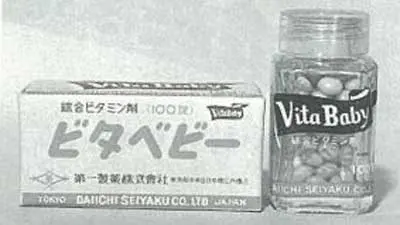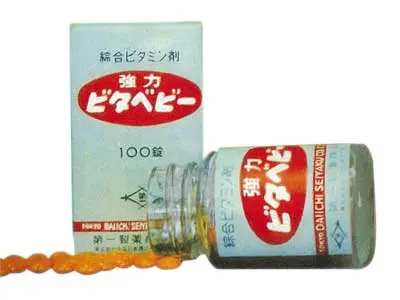In 1951, Daiichi Sankyo predecessor company, Sankyo Co., Ltd. (Sankyo), launched the cold remedy, “Lulu,” which can still be found in drugstores in Japan today.
Owing to the popular advertising slogan, “Three sneezes, three Lulu tablets,” as well as to product improvements and expansions in the product line-up. Daiichi Sankyo’s other predecessor company, Daiichi Pharmaceutical Co., Ltd. (Daiichi), also launched a product around the same time, again with a slogan containing numbers and a strong focus on advertising. This was the multivitamin product known as “Vita Baby.”
A multivitamin easily accessible to consumers
In 1952, when Daiichi launched “Iscotin,” a new chemotherapeutic agent to treat tuberculosis, Japan had just gained independence from the post war General Headquarters administrative authority with the signing of the San Francisco Peace Treaty, and the nation’s economy slowly started to grow as consumption increased.
Commercial radio was introduced in 1951 and commercial television in 1953, and various companies began using TV to advertise their services and products. Similarly, the pharmaceutical industry launched and actively promoted a series of pharmaceutical “mass media products” that could be purchased directly by consumers. Against that backdrop, in May 1953, Daiichi launched “Vita Baby,” a multivitamin that any consumer could purchase.

Vita Baby features square bottles and designs that children
will love
A hit product with a child-friendly design and easy-to-swallow taste
Developed to meet the health needs of Japan’s changing diet and lifestyle, Vita Baby contained a combination of 10 essential vitamins. The adoption of sugar-coated tablet technology, originally used in the manufacture of confectionery, also made the small tablets easier for people to take and also prevented changes in the properties of the drug.
At the time, other pharmaceutical companies were also selling multivitamins, increasing competition for sales. As a result, Daiichi decided to modify the packaging of the product by changing the Vita Baby bottle to an unconventional rectangular shape and the box to a child-friendly design. The company also tried to make the product more appealing to parents and children by including cards with animals printed on them, which included a lottery to win prizes, and by publishing a “National Kindergarten Newspaper.”

"Strong Vita Baby" with enhanced ingredients
Raising awareness with slogans, catchy commercial jingles, and product renewal
Daiichi also focused on advertising and made extensive use of commercial radio, newspapers, and magazines. The slogan “One for the boy, three for the mom” was created and used in commercials.
This was followed by the airing of the commercial song “Zu Zun-To Zun-To,” which was written by Hachiro Satoh, a well-known lyricist known for the postwar hit, “Ringo no Uta” (The Apple Song), and “Ureshii Hinamatsuri” (Happy Doll Festival), and “Chiisai Aki Mitsuketa” (I’ve Found a Little Autumn), which are children’s songs that are still popular today. Additional efforts were made to promote these products through outdoor advertising and promotional vehicles.
In 1958, “Kyoryoku (meaning ‘extra strength’) Vita Baby,” a renewed product with fortified ingredients, was launched. Vita Baby thus became a pharmaceutical product that raised Daiichi’s public profile, following in the footsteps of “Therapol,” the first domestically produced sulfa drug that was highly regarded until the advent of antibiotics in 1937, and “Rutinon,” a vasodilator and cerebral hemorrhage prevention agent that became immensely popular after its launch in 1949.
In keeping with the changing times of the mid-20th century, in addition to innovative prescription medicines, Daiichi also produced over-the-counter medicines that could be used daily by a wider population. This passion and spirit have been passed down to Daiichi Sankyo today.